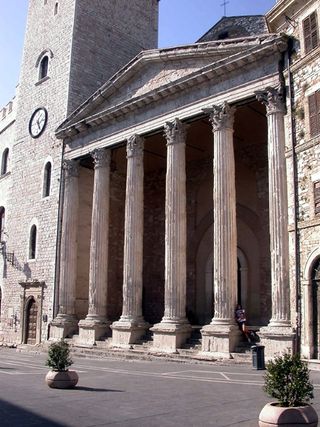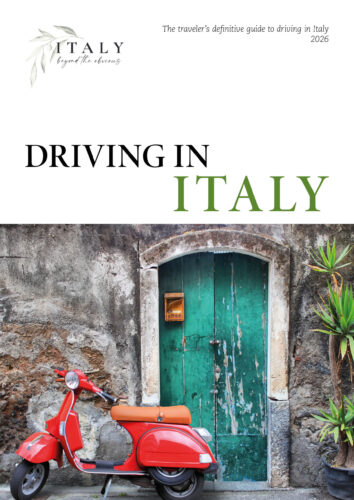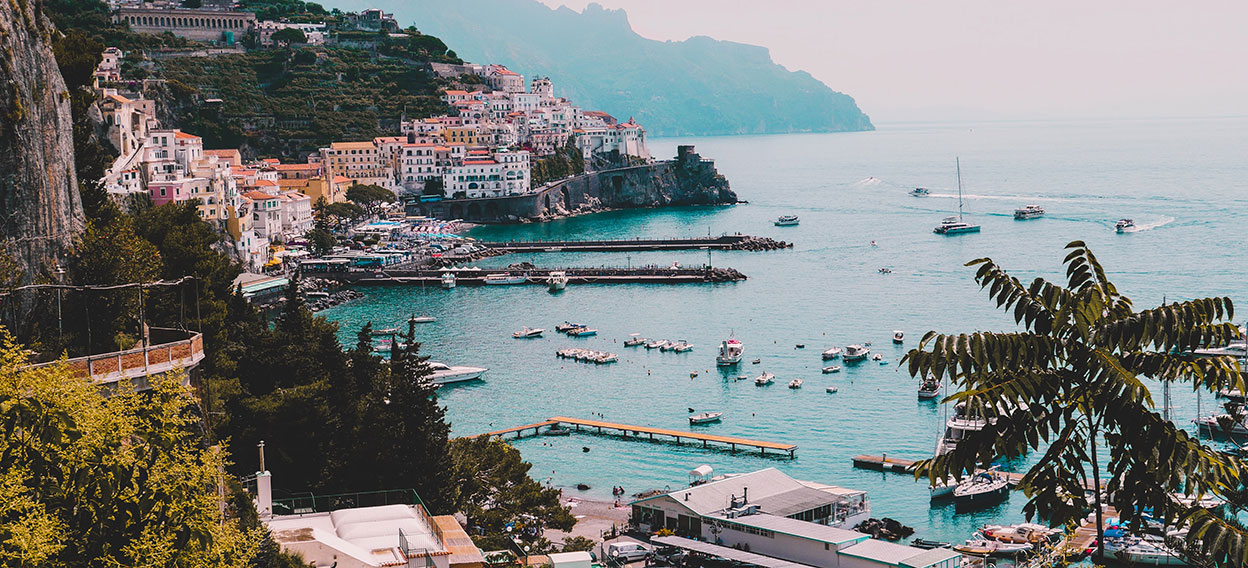
Roman Assisi
One of the most beautifully written articles about Assisi that I’ve ever come across is by the author of today’s guest post, Rebecca Winke. Below, she delves into the fascinating evidence of the city’s Roman past, which is being uncovered as we write. Welcome and thank you Rebecca!
It’s easy to forget, with all the furor surrounding the legacy of Assisi’s most famous citizen, that long before Francis walked the cobblestoned streets of Ascesi, Roman poet Sextus Propertius walked the paved roads of Asisium. And long before busloads of contemporary pilgrims began invading Umbria’s most charming hill town to gape at the imposing Basilica dedicated to the Saint, travellers on Europe’s Grand Tour from the 17th to 19th centuries eschewed this medieval monument and instead visited Assisi’s excellent Roman sites.
Unfortunately, Assisi’s lovely and important Roman monuments—dating primarily from the first century bC—had been largely neglected over the past century, as attention (and funds) were funneled toward religious tourism. This has changed over recent years and many sites have been newly renovated or opened to the public for the first time. Though I don’t recommend following in the footsteps of Goethe and skipping the Basilica of Saint Francis altogether, consider taking the time during your visit to Assisi to discover her rich Roman roots.
Begin in the main Piazza del Comune, where, you may be surprised to learn, the most intact Roman temple front in Italy still survives. The fluted Corinthian columns in the Temple of Minerva’s facade (photo above) are incorporated directly into the pronaos’ flight of travertine stairs instead of resting level with the portico’s floor at the top, a trick used by the first century bC architect to squeeze both the grand staircase and the covered porch—typical of Roman religious architecture and familiar to anyone who has seen Tom and Jerry cartoons—into the relatively narrow forum (now the piazza). The interior of this shrine dedicated to the goddess of virginity has been replaced by a gaudy Baroque Catholic chapel during the ensuing millenia, so take a seat on one of the benches facing the temple across the piazza (preferibly with a towering gelato in hand) and use the view of the facade to help your imagination conjure up the classical world.
To put the Temple of Minerva into context, head just a few meters away on Via Portica to the entrance to Assisi’s Roman Forum and Archaeological Museum. Completely restored in 2008, the museum unfortunately remains a largely uninspired—and uninspiring—warehouse-like collection of tersely identified Roman architectural elements, inscriptions, and artifacts recovered from sites in Assisi and environs. It is, however, worth a quick visit to see the scale model which reconstructs the layout of the Roman forum (photo above), the remains of which you reach by following the museum’s long corridor which leads directly underneath the modern piazza, the foundation of the Temple of Minerva, which is level with the underground museum, and three lovely marble statues unearthed in Assisi, one of which represents Minerva herself.
Now that you’ve seen where the Romans worshipped, it’s time to see where they lived. In the nineteenth century, excavations near the Church of Santa Maria Maggiore in Piazzetta Garibaldi uncovered the remains of a luxurious Roman villa, or domus, with its original mosaic floor, painted wall decorations, and a long section of richly decorated vault-covered portico (cryptoporticus), which most likely surrounded an open central garden. After years of excavation and extensive restoration work, the so-called Domus Propertius (for a mistaken attribution to the poet Propertius) is now open by appointment for a limited number of groups and, given that it showcases one of the few known examples of Roman mural painting north of Rome, is a must-see for anyone passionate about Roman civilization. Especially charming is the niche (viridarium) covered with a delicate decorative painted motif of green boughs, small heart-shaped blossoms, and a number of tiny songbirds, each slightly different from the next (photo above).
The Domus Propertius is merely an amuse-bouche to the breathtaking remains currently being excavated and restored (slated for completion in late 2011) under the Palazzo Giampé next door. This site is particularly important, both for the type of structure–including a peristylium (garden surrounded by a colonnade), a diaeta (sitting room), a triclinium (dining room), and a cubiculum (bedroom)–and for the excellent frescoes depicting architectural elements, griffins and birds, and a portrait of a married couple. Just last month, archaeologists announced having unearthed a sprawling 10 meter by 6 meter perfectly conserved mosaic floor, in black, white, green, and red. When this site is finally opened to the public, it will be one of the most important and intact examples of a Roman domus on view in Italy.
But for now, you will have to settle on the lovely teaser of the Domus Propertius, and move on to see where the Romans played. Roman Asisium boasted a large amphitheater, of which nothing remains above ground but its round shape, lined with small houses built during the Middle Ages (with stone pilfered from the ancient monument), off of contemporary Piazza Matteotti. That said, when the nearby luxury Nun Hotel and Spa (located in the restored former convent of Santa Caterina) opened their doors in 2010, they revealed what had been unearthed during construction work: extensive remains of the amphitheater, including six towering pillars made of immense limestone ashlar masonry, a polished pink limestone staircase topped with a rectangular podium, (which once led to the shrine dedicated to the curative waters of the nearby Perlasio spring), two shallow stone pools (probably used for ritual baths), and two immense vaulted cisterns. The bad news is that the ruins (photo above) have been artfully incorporated into the chic and elegant spa, and are on view only for spa clients. The good news is that the ruins have been artfully incorporated into the chic and elegant spa, and are on view only for spa clients. So book yourself in for a few hours of hammam downtime and a massage to recover from your arduous day of touring, and chalk it up to culture. After all, when in Asisium, do as the Asisinates did.
A heartfelt thanks to Raffaella Tarrara of Sistema Musei and Maria Laura Manca of the Soprintendenza per i Beni Archeologici dell’Umbria.
Information:
Temple of Minerva
Piazza del Comune
Open: 10:30-13:00/14:00-17:00
Museo Civico e Foro Romano
via Portica, 2 Assisi (Perugia)
Open:
10,30 – 13,00 and 14,00 – 17,00 Nov- Feb
10,00 – 13,00 and 14,30 – 18,00 March-May/Sept-Oct
10,00 – 13,00 and 14,30 – 19,00 June-August
Domus Propertius
Santa Maria Maggiore, Piazzetta Garibaldi
Open upon appointment only for groups up to 15, a maximum of eight times a month.
Phone Sistema Museo (800 961993) to make an appointment
Nun Hotel and Spa Museum
Via Eremo delle Carceri, 1°
Open: 10:00-20:00
To book an appointment, call 075 8155150
Rebecca Winke – Innkeeper and Blogger
Rebecca moved to Italy from Chicago in 1993 and shortly thereafter opened an agriturismo in her husband’s renovated family farmhouse at the foot of Mount Subasio near Assisi, Umbria. She spends her time taking care of guests at Brigolante, blogging about the lovely region she now calls home at Rebecca’s Ruminations, and wondering about what strange winds blew an urban vegetarian to a pig farm in Umbria.
Photos: rights to the first three photos belong to the Soprintendenza Archaeologica Dell’Umbria; last photo belongs to Nun Hotel and Spa Museum






